Breeding rabbits can be a very profitable business. The fact is that this niche of the domestic market is still practically not occupied. The reason is, most likely, that our compatriots for a long time considered rabbit meat waste and bought it not too willingly. However, recently, in connection with the desire of many to maintain a healthy lifestyle, interest in this product has increased (as well as its cost). Indeed, many people know that rabbit meat is dietary and also very tasty.
How to organize a farm and save
According to most experts, breeding rabbits in a pit is the simplest and cheapest technology. All that is needed to organize such a farm is to purchase or rent a small plot of land. In each dug pit, up to 200 rabbits can live. According to most rabbit breeders, cleaning with this method of keeping is somewhat more difficult than with an aviary, but much easier than with a cage. Procedures such as feeding and drinking, in this case will also be simplified as much as possible.
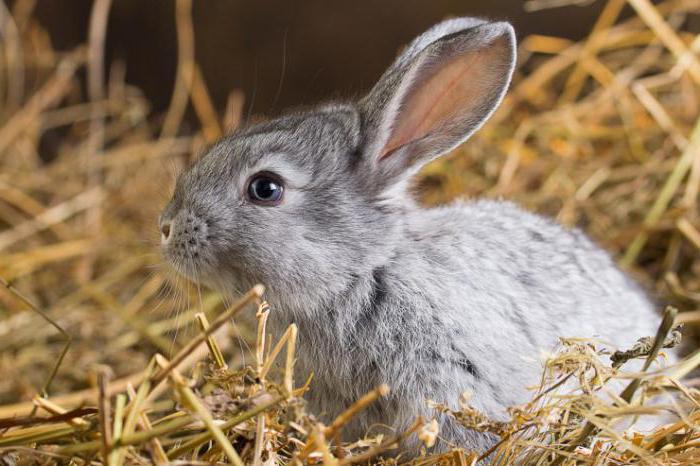
How to register a new company
Thus, raising rabbits in pits as a business may not be too expensive at first, not particularly troublesome, and very profitable. check in rabbit farms Like any other agricultural enterprises, it is usually produced as a peasant farm. Good reviews of this type of business are also available because the state has recently paid a lot of attention to the development of livestock and crop farms. In any case, the procedure for registering a new enterprise is unlikely to be too complicated.
Some novice rabbit farmers are registered and simply as a PI. With either of these two forms of organization of the enterprise, taxes can be paid in either a regular or a simplified way. Among other things, in our country at the moment, beginning farmers often receive material support. True, the amount can be obtained only very small (about 50-60 thousand rubles).
How to start organizing the farm itself
According to most rabbit breeders, the success of an enterprise of this specialization primarily depends on the correct choice of site. It is best if the farm is located near a city. In this case, it is easier to find markets for meat. But the distance from the farm to the village, according to the standards, should not be too close either. When choosing land, this should be taken into account. Also, when searching for a suitable plot, experienced farmers are advised to keep in mind the following points:
- With a high level of surface water, rabbit breeding in the pit becomes impossible. Under no circumstances should minks be flooded.
- The environmental situation around the site should be as favorable as possible.
- There should be a suitable soil composition on the site you are looking for. Rabbits dig very well. However, if the soil is very dense, clay or rocky, mink animals will refuse to build.
Once the site is selected, you can start digging holes for rabbits. Of course, such dwellings for animals must be properly equipped. Yes, and the actual breeding of rabbits in the pit at home will have some nuances.
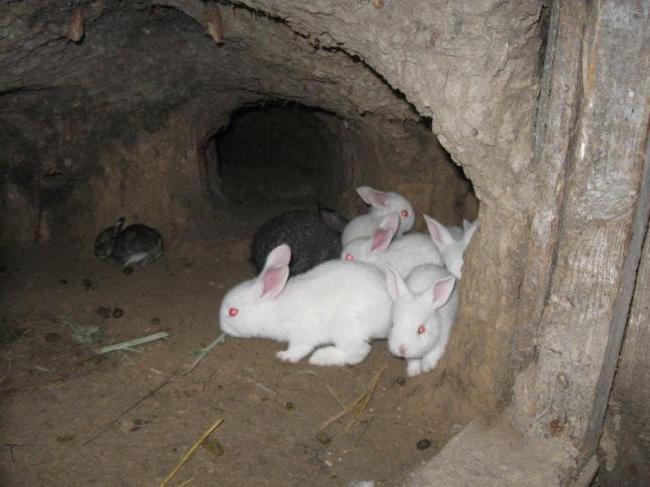
What should be the pit
The shape of such underground "dwellings" for rabbits, according to experienced fur farmers, can be any. Pits are dug round, rectangular and even triangular.The main thing is that their area is approximately 2 m2, and the depth was not less than 1 m. The rabbits planted in the pit are quickly mastered and begin to dig holes. If the pit is too shallow, according to various signs (the presence of a spine, seeds, etc.), the animals will very quickly guess the proximity of "freedom", dig a course and run away. If the entrances are at least 1 m deep, the animals will begin to dig horizontal or even slightly going down holes. In general, this occupation in terms of losing pets with the right approach is quite safe - breeding rabbits in a pit. The layout of the pit is presented for your attention below.
The length of the rabbit passages can reach 20-40 m. However, they are usually very highly branched. However, it is not worth fearing that the animals will undermine the foundations of any buildings or damage the roots of fruit trees. These animals are not so strong.
How to equip a farm
Breeding rabbits in pits as a business will be successful only if the animals provide good living conditions. Above the freshly dug pits, small wooden structures with a roof should be installed. This will prevent the penetration of rain and snow, as well as various kinds of predatory animals. Three sides of each pit are usually sheathed with slate. This is optional, but can prevent uncontrolled digging of holes. Along the closed walls set feeders and drinking bowls.
Sand should be poured at the bottom of dug holes with a layer of a thickness of at least 20 cm. Subsequently, it will absorb urine, which will prevent the appearance of an unpleasant odor and the spread of infection. Lay a mesh on the sand. Subsequently, this will facilitate cleaning.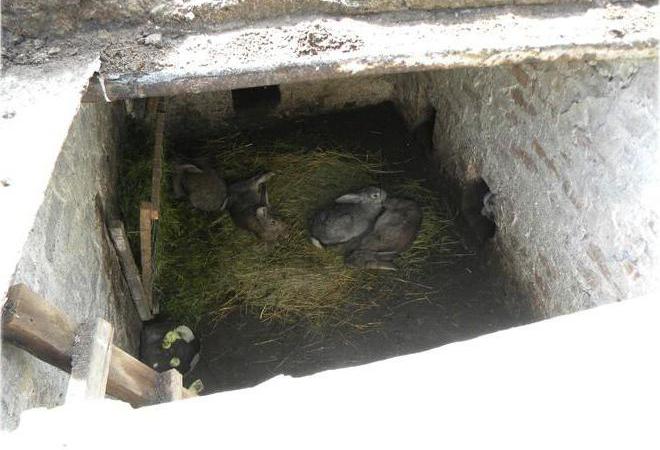
Rabbit breeding in the pit: reviews of farmers
Of course, a novice entrepreneur should know about all the pros and cons of pit animals. How do experienced rabbit breeders relate to this technique? Reviews about pit breeding are different. Animal farmers are usually very conservative. Although the pit method is the oldest rabbit breeding technology, many are in no hurry to switch to it. The fact is that over the past few decades in all countries of the world, mainly the cellular method of keeping these animals has been practiced. Many farmers are just used to raising rabbits that way. The pit breeding method is used mainly by young beginner fur farmers who decided to save money or simply conduct a small experiment in order to find out the advantages and disadvantages of this technology. Whatever the case, many find many advantages in such a growing technique.
Technology advantages
The advantages of such a method as raising rabbits in a pit, in addition to low cost, many farmers include:
- Rapid growth and weight gain by animals. Rabbits - animals are very active. In cells, they feel depressed, and therefore develop more slowly. In the pit, these animals feel relatively free and do not experience any stress.
- A lower incidence rate. The most favorable microclimate is created in the pit for rabbits. It is warm in winter, and cool in summer. Drafts are excluded by definition. Therefore, pit rabbits almost never catch a cold. The risk of developing infectious diseases in this case is also small. The main carriers of infection in rabbitry are insects. Neither flies nor mosquitoes penetrate the pit.
- Simplicity in leaving. Clean the bottom of the pit approximately 1-2 times a week. In this case, you can use a regular shovel.

The main disadvantage of this method
Opponents of such technology as breeding rabbits in a pit consider it impossible to control the reproduction of animals as its main disadvantage. The owners of such farms have to take additional measures to prevent degeneration of the herd. After all, everyone knows that incest between rabbits is extremely undesirable.
To avoid the birth of very small and non-viable rabbits, it is required to change the producer once every six months. Some farmers leave teenage males in pits. Their number usually does not affect fertility. The fact is that in rabbits, the dominant male usually castrates competitors on their own. But sometimes this still does not happen. If a “superfluous” mobile pugnacious and too well-fed rabbit, actively interested in females, is noticed in the pit, he should be immediately put out. To eliminate the risk of degeneration, experienced rabbit breeders also advise to completely change the herd once every few years.

How to catch rabbits
Breeding rabbits in a pit (the scheme of such a dwelling clearly shows the simplicity of its arrangement) has another small minus. The fact is that catching animals in this case is quite difficult. In the pits, rabbits master very quickly and even slightly run wild. Therefore, for trapping sometimes it is necessary to use special devices. The simplest is a shield on a rope above the entrance to the hole. In some cases, special valve-type devices are also used. If necessary, they are installed before entering the hole. Rabbits can go out through them, but they can’t go back - no.
But more often than not, all fur farmers are advised to just try to organize a catch based on a conditioned reflex. Most often, this is the usual invocation whistle from the owner when feeding.
Animal diseases
Rabbits, breeding and keeping in the pits of which can become a business are quite profitable, unfortunately, animals are not too resistant to diseases. Therefore, according to all farmers without exception, epidemics are a very serious danger with this method of cultivation. After all, in this case it is not possible to isolate sick rabbits from the herd. So if any infection does get into the pit, the losses will be colossal. Most likely, all the rabbits will die. Therefore, it is imperative to monitor the quality of feed and cleanliness in the "home" of animals.
Animals are first launched into a pit usually at the age of 3-4 months. Of course, animals must first be vaccinated. This is one of the basic rules of such a procedure as raising rabbits in pits. Diseases and treatment of pets in this case can become a really very serious problem.
Even if only one rabbit dies in the pit, this can cause concern to the farm owners. After all, to get and bury the carcass will simply be impossible. However, as many rabbit breeders say, animals usually arrange a “funeral” themselves. Animals simply bury the mink in which their fellow died.
Feeding rabbits in a pit
Diet for animals bred in this way, experienced fur farmers are advised to make the usual. That is, animals need to be given barley (sometimes oat) crusher, hay, branches and root crops. Grass is fed in the dried state in summer. It is better not to throw hay and branches on the ground, but to hang them in pits on ropes so that the rabbits can reach them.
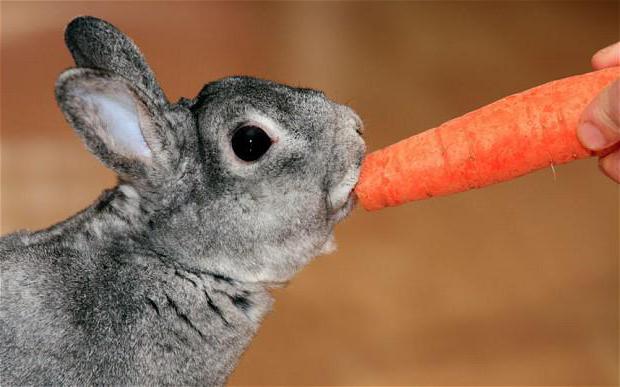
Breeding rabbits in the pit
The inability to control reproduction, as already mentioned, is considered the main disadvantage of such technology as breeding rabbits in pits. Photos of quite happy animals living in such "dwellings" in huge numbers, however, can be seen on this page. Despite the fact that controlled mating is not possible with this method of keeping, the reproduction of rabbits in a pit in most cases is a quite successful process. With timely replacement of producers, the herd will grow very quickly and without loss of inherent qualities of the breed. The females of the stillborn babies are thrown from the hole into the pit. No cleaning of the nest after the rabbits have grown is not required. Uterus never gives birth in the same hole twice. Moreover, they bury the old one tightly.
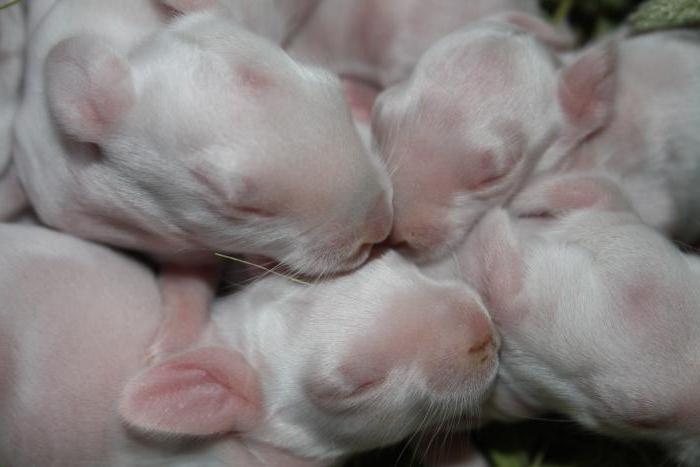
Pit with access to the aviary: how to make
This method of breeding animals is also practiced by breeders and is considered potentially very successful. In this case, the hole is dug up directly in the aviary. A gentle descent (no steeper than 45 gr.) With a ladder is arranged in it. The steps of the latter should have a very small height. Otherwise, cubs will not be able to get out. Breeding rabbits in a pit with access to the aviary is a bit more expensive, but in this case it’s more convenient to take care of the animals and catch them.








